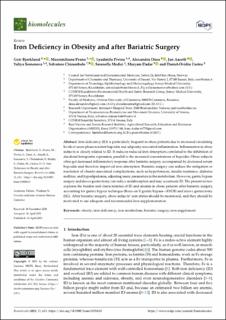| dc.contributor.author | Bjørklund, Geir | |
| dc.contributor.author | Peana, Massimiliano | |
| dc.contributor.author | Pivina, Lyudmila | |
| dc.contributor.author | Dosa, Alexandru | |
| dc.contributor.author | Aaseth, Jan | |
| dc.contributor.author | Semenova, Yuliya | |
| dc.contributor.author | Chirumbolo, Salvatore | |
| dc.contributor.author | Medici, Serenella | |
| dc.contributor.author | Dadar, Maryam | |
| dc.contributor.author | Costea, Daniel-Ovidiu | |
| dc.date.accessioned | 2023-12-11T12:27:09Z | |
| dc.date.available | 2023-12-11T12:27:09Z | |
| dc.date.created | 2021-07-15T12:18:17Z | |
| dc.date.issued | 2021 | |
| dc.identifier.citation | Biomolecules. 2021, 11 (5), . | en_US |
| dc.identifier.issn | 2218-273X | |
| dc.identifier.uri | https://hdl.handle.net/11250/3106846 | |
| dc.description.abstract | Iron deficiency (ID) is particularly frequent in obese patients due to increased circulating levels of acute-phase reactant hepcidin and adiposity-associated inflammation. Inflammation in obese subjects is closely related to ID. It induces reduced iron absorption correlated to the inhibition of duodenal ferroportin expression, parallel to the increased concentrations of hepcidin. Obese subjects often get decreased inflammatory response after bariatric surgery, accompanied by decreased serum hepcidin and therefore improved iron absorption. Bariatric surgery can induce the mitigation or resolution of obesity-associated complications, such as hypertension, insulin resistance, diabetes mellitus, and hyperlipidemia, adjusting many parameters in the metabolism. However, gastric bypass surgery and sleeve gastrectomy can induce malabsorption and may accentuate ID. The present review explores the burden and characteristics of ID and anemia in obese patients after bariatric surgery, accounting for gastric bypass technique (Roux-en-Y gastric bypass—RYGB) and sleeve gastrectomy (SG). After bariatric surgery, obese subjects’ iron status should be monitored, and they should be motivated to use adequate and recommended iron supplementation. Keywords: obesity; iron deficiency; iron metabolism; bariatric surgery; iron supplement | en_US |
| dc.language.iso | eng | en_US |
| dc.publisher | MDPI | en_US |
| dc.relation.uri | https://www.mdpi.com/2218-273X/11/5/613 | |
| dc.rights | Navngivelse 4.0 Internasjonal | * |
| dc.rights.uri | http://creativecommons.org/licenses/by/4.0/deed.no | * |
| dc.subject | obesity; | en_US |
| dc.subject | iron deficiency; | en_US |
| dc.subject | iron metabolism; | en_US |
| dc.subject | bariatric surgery; | en_US |
| dc.subject | iron supplement; | en_US |
| dc.title | Iron Deficiency in Obesity and After Bariatric Surgery | en_US |
| dc.type | Peer reviewed | en_US |
| dc.type | Journal article | en_US |
| dc.description.version | publishedVersion | en_US |
| dc.rights.holder | © 2021 by the authors. Licensee MDPI, Basel, Switzerland. This article is an open access article distributed under the terms and conditions of the Creative Commons Attribution (CC BY) license (https://creativecommons.org/licenses/by/4.0/). | en_US |
| dc.source.pagenumber | 15 | en_US |
| dc.source.volume | 11 | en_US |
| dc.source.journal | Biomolecules | en_US |
| dc.source.issue | 5 | en_US |
| dc.identifier.doi | 10.3390/biom11050613 | |
| dc.identifier.cristin | 1921837 | |
| cristin.ispublished | true | |
| cristin.fulltext | original | |
| cristin.qualitycode | 1 | |

